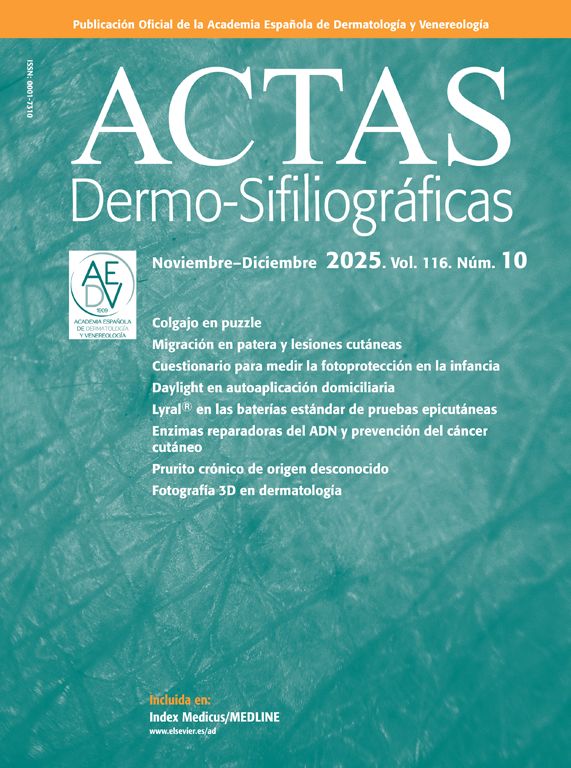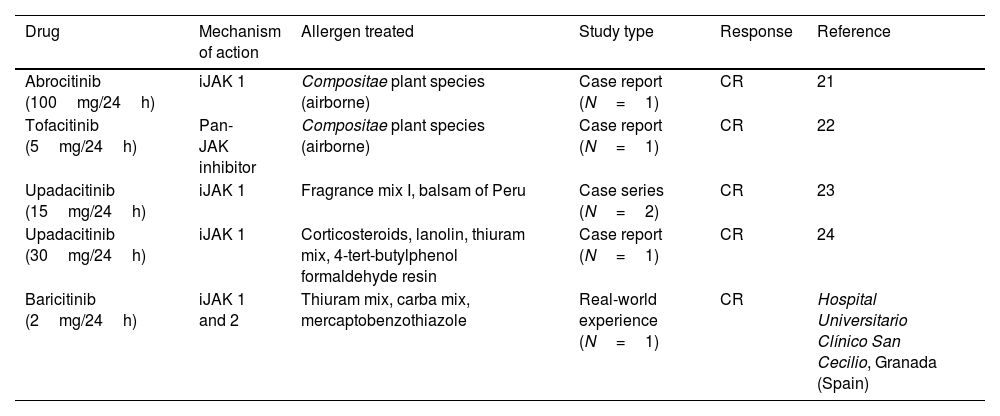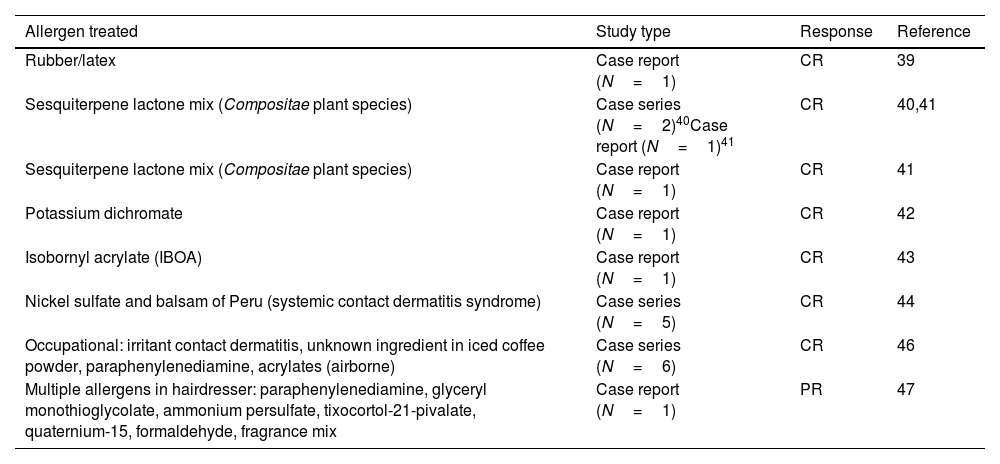The resistant and recalcitrant nature of severe allergic contact dermatitis (ACD) makes treatment challenging. With advances in the understanding of the cellular and molecular pathogenesis of this dermatosis, new therapeutic options are emerging. In particular, the use of biologic drugs such as dupilumab and small molecule inhibitors, such as JAK inhibitors have gained momentum given the cross-cutting inhibition of multiple cytokine actions. This article aims to review the current available data on the use of biologic drugs and small molecule inhibitor drugs in the management of ACD. Results suggest that iJAKs, such as abrocitinib, tofacitinib, upadacitinib, and baricitinib; although biologic drugs, such as dupilumab show significant promise in refractory ACD, more long-term clinical trials are needed to confirm their safety and efficacy profile.
La naturaleza resistente y recalcitrante de la dermatitis de contacto alérgica (DCA) grave hace que su tratamiento sea desafiante. Con los avances en la comprensión de la patogénesis celular y molecular de esta dermatosis, están surgiendo nuevas opciones terapéuticas. En particular, el uso de fármacos biológicos como dupilumab e inhibidores de moléculas pequeñas (como los inhibidores de JAK) han cobrado impulso, dada la inhibición transversal de las acciones de múltiples citoquinas. Este artículo tiene como objetivo revisar los datos disponibles actuales sobre el uso de fármacos biológicos y fármacos inhibidores de moléculas pequeñas en la DCA. Los resultados sugieren que los iJAK, como abrocitinib, tofacitinib, upadacitinib y baricitinib; y los fármacos biológicos, como dupilumab, muestran promesas significativas en la DCA refractaria, aunque se necesitan más ensayos clínicos a largo plazo para confirmar su eficacia y seguridad.
Contact dermatitis accounts for an estimated 4–7% of dermatological consultations.1 The prevalence of allergic contact dermatitis (ACD) is unknown, although some studies have estimated it to be between 1.7% and 9.8%,2 with occupational ACD being particularly significant.3 ACD presents with different clinical patterns depending on the affected area. Recognizing these patterns can not only aid physicians in diagnosis but also suggest potential allergens and forms of contact.4 The gold standard for investigating these patients remains patch testing, with a relevant positivity rate between 15% and 20.1% of patched patients.5 All patients should be tested with the national standard series,6 their own products,7 and, depending on the case characteristics and exposure sources, additional commercially available specific series. Identifying the responsible allergens and avoiding them is not always sufficient to resolve the problem, requiring the prescription of topical and/or systemic immunosuppressive treatment in refractory cases. The lack of response to allergen avoidance and the limitations of traditional treatments highlight the need for new therapies.8 Recent research into small molecule inhibitors and biological drugs offers new hope, especially for those who do not respond to conventional approaches.
In the routine clinical practice, it may not be possible to perform patch testing after suspending immunosuppressive medication, which increases the risk of false negatives.9 Patients with polysensitization (3 or more allergens) on patch tests are a difficult-to-manage group, with an increased risk of refractoriness after attempting avoidance.10
In recent years, there has been progress in understanding the pathophysiology of ACD and the different groups of allergens.11 This information provides an opportunity to consider advanced targeted treatments, off-label, for the control of ACD refractory to the avoidance of identified allergens. During the initial phase of the type IV hypersensitivity process, the innate immune system actively participates after the formation of the antigenic complex, inducing the release of cytokines such as IL-1α, IL-1β, TNF-α, IL-8, IL-18, and granulocyte-macrophage colony-stimulating factor.12 Prior to the sensitization phase, the antigen-presenting cell captures the hapten to present it to naive T lymphocytes in the regional lymph node, which can recognize it and activate the Th1 pathway if IL-12 is released, Th2 if IL-4 is released, Th17 if IL-17 or IL-23 is released, or Th22 if IL-22 is released.13,14 Activation of regulatory T lymphocytes is also possible. In the last decade, the inflammatory specificity of some allergens has been more precisely defined, such as nickel sulfate with predominantly Th1 and Th17 cytokines, fragrances with predominantly Th2 inflammation, and rubber (latex) related to Th2 and Th22 type inflammation.14Table 1 illustrates the main allergens studied from a molecular point of view and the inflammatory pathways they activate.
Understanding that assigning specific immunogenic profiles to each allergen (or group of them) can be complex, and that we are likely talking about inflammatory predominances, the use of drugs with specific therapeutic targets in these patients remains interesting. Currently, and broadly speaking, we can classify therapeutic options into two groups: small molecule inhibitors such as Janus kinase inhibitors (JAKi), and biological therapies (monoclonal antibodies directed against IL-4, 13, 17, 12, 23, immunoglobulin E [IgE], and TNF-α). None of these commercially available treatments are approved for the treatment of ACD; therefore, their request will be off-label.8
This review excluded the study of classic immunosuppressants, such as corticosteroids, cyclosporine, methotrexate, mycophenolate, or azathioprine, in the treatment of ACD.15 This decision was made because these do not represent novel treatments.
Material and methodsWe conducted a narrative literature review on PubMed up to July 28th, 2024, using specific terms related to ACD and new therapies: “allergic contact dermatitis,” “allergens,” “delayed-type hypersensitivity reaction,” “patch test,” “Jak inhibitors,” “iJak,” “biologics,” “biological therapy,” “monoclonal antibodies,” “abrocitinib,” “tofacitinib,” “upadacitinib,” “baricitinib,” “ruxolitinib,” “delgocitinib,” “apremilast,” “roflumilast,” “crisaborol,” “difamilast,” “dupilumab,” “tralokinumab,” “nemolizumab,” “lebrikizumab,” “secukinumab,” “ustekinumab,” “omalizumab,” “anti-TNF,” “infliximab,” “adalimumab,” “etanercept,” “certolizumab,” and “certolizumab pegol.” Studies in English and Spanish evaluating the safety and efficacy profile of small molecule inhibitors and biological drugs in ACD were included. Studies focused on traditional treatments, such as corticosteroids and classic immunosuppressants, were excluded given their non-novel nature. Articles were selected based on the relevance of their abstracts and were evaluated in detail after full-text reading.
Small molecule inhibitorsJAK inhibitors (JAKi): abrocitinib, tofacitinib, upadacitinib, baricitinib, ruxolitinib, and delgocitinibThe intracellular signaling pathway Janus kinase/signal transducer and activator of transcription (JAK/STAT) is initiated when an extracellular ligand binds to transmembrane receptors, leading to the phosphorylation of intracellular molecules. This triggers an intracellular signaling cascade and regulates the transcription of numerous genes. JAKs are part of this family of tyrosine kinases that function as intracellular signal transducers and include JAK1, JAK2, JAK3, and TYK2. JAKs form dimers in the intracellular cytoplasmic portion of cytokine receptors, allowing them to associate with multiple receptors and be activated by different cytokines. In turn, they activate various STAT proteins, such as STAT1, STAT2, STAT3, STAT4, STAT5a, STAT5b, and STAT6, thus participating in specific biological functions. When these STAT proteins are activated, they associate forming dimers and can translocate to the cell nucleus. There, they act as transcription factors, upregulating the expression of genes responsible for the production of pro-inflammatory cytokines and growth factors, and regulating the behavior of other intracellular proteins.16 JAKi have emerged as a therapeutic class with multiple applications in dermatology (vitiligo, alopecia areata, psoriasis, and atopic dermatitis).17,18 It is postulated that JAKi could be a promising therapeutic option in cases resistant to conventional therapies for ACD.19 These drugs have been shown to influence multiple inflammatory pathways, including the TH1, TH2, and TH17 pathways that are involved in the pathophysiology of ACD.20 The efficacy of JAKi may vary depending on the specific allergen involved, highlighting the importance of an individualized evaluation. Although clinical research in this field is still limited, cases have been documented where treatment with JAKi showed encouraging results. For example, the use of abrocitinib at a dose of 100mg every 24h in a 37-year-old man with airborne ACD caused by plant particles of the Compositae (Asteraceae) family, with occupational exposure in a work environment where allergen avoidance was unfeasible, resulted in complete resolution of symptoms 8 months into therapy without adverse effects.21 This patient had previously shown a lack of response to treatment with dupilumab 300mg every 2 weeks for 11 months, suggesting that the allergen in question activates other inflammatory pathways not related to the Th2 pathway.
Another case reported the therapeutic success of tofacitinib 5mg every 12hafter a 4-week regimen without side effects in a 57-year-old Indian woman with airborne ACD to Parthenium, a genus of plants in the Compositae (Asteraceae) family.22 This patient had previously been on topical and oral corticosteroids, topical tacrolimus 0.1%, and azathioprine without response. These findings support the viability of JAKi as a therapeutic option in selected cases of ACD.
Recently, 2 cases of patients with psoriasis and ACD to fragrance mix I and balsam of Peru, with good response to upadacitinib 15mg daily, have been published.23 The use of upadacitinib 30mg also silenced the allergic reaction to multiple allergens (corticosteroids, lanolin, thiuram mix, 4-tert-butylphenol formaldehyde resin) when repeating patch tests in the same patient after 4 months of into upadacitinib 30mg.24 This is important not only because it may be an interesting therapeutic tool but also to avoid performing patch tests in patients on this type of drug due to the high risk of false negatives. We have experience treating ACD with rubber accelerators (thiuram mix, carba mix, and mercaptobenzothiazole) in a patient refractory to cyclosporine, who responded completely within 4 weeks into baricitinib 2mg/24h (Fig. 1). We have not found any published cases of ACD on topical ruxolitinib or delgocitinib, but we suspect that after their commercialization, new cases of ACD treated with these topical drugs will be published. Table 2 illustrates the findings regarding JAKi in the treatment of ACD.
JAK inhibitors (iJAK): drug, mechanism of action, ACD with sensitization to relevant present allergen treatable or capable of silencing on patch tests, study type, response, and reference.
| Drug | Mechanism of action | Allergen treated | Study type | Response | Reference |
|---|---|---|---|---|---|
| Abrocitinib (100mg/24h) | iJAK 1 | Compositae plant species (airborne) | Case report (N=1) | CR | 21 |
| Tofacitinib (5mg/24h) | Pan-JAK inhibitor | Compositae plant species (airborne) | Case report (N=1) | CR | 22 |
| Upadacitinib (15mg/24h) | iJAK 1 | Fragrance mix I, balsam of Peru | Case series (N=2) | CR | 23 |
| Upadacitinib (30mg/24h) | iJAK 1 | Corticosteroids, lanolin, thiuram mix, 4-tert-butylphenol formaldehyde resin | Case report (N=1) | CR | 24 |
| Baricitinib (2mg/24h) | iJAK 1 and 2 | Thiuram mix, carba mix, mercaptobenzothiazole | Real-world experience (N=1) | CR | Hospital Universitario Clínico San Cecilio, Granada (Spain) |
ACD: allergic contact dermatitis; CR: complete response.
No data on delgocitinib, ruxolitinib, roflumilast, or difamilast. Topical crisaborol can cause ACD.29,30
Phosphodiesterase 4 (PDE4) is an enzyme responsible for the degradation of cyclic adenosine monophosphate (cAMP), which promotes the production of inflammatory mediators (cytokines: TNF-α, IL-1β, and IL-6) and the activation of immune cells (T lymphocytes, macrophages, and mast cells) systemically and epidermally. The use of PDE4i in ACD would help limit the inflammatory response and preserve the skin barrier function against allergens and irritants. There are few publications on their use in ACD. Apremilast was used in an open-label phase 2 trial for recalcitrant ACD and/or AD, in which 10 patients participated at a dose of 20mg twice daily for a period of 12 weeks, 4 of whom had ACD and 1, coexisting ACD and AD.25 The primary endpoint was set at a 2-point improvement in the IGA (Investigator Global Assessment), which was achieved in 20% of the subjects. Only 10% achieved EASI-75 (Eczema Area and Severity Index-75), leading to the conclusion of its limited effect for these patients vs the results obtained in psoriasis.25 However, an interesting finding was observed in this trial: subjects diagnosed with ACD responded better to apremilast vs patients with AD. ACD patients showed an average improvement of 40% in the EASI score, while AD patients experienced a 20% worsening (p=0.026). Furthermore, ACD subjects presented a 30% reduction in pruritus, in contrast to a 10% reduction in AD patients. However, this difference in pruritus was not statistically significant, likely due to the small sample size. This finding suggests that apremilast might be more effective in the treatment of ACD than AD, although it should be noted that ACD patients had lower baseline EASI scores, with a mean of 12.5, compared to AD patients, who had a mean of 34.1; therefore, a larger number of patients is needed to confirm these results.25
Roflumilast is a drug indicated for chronic obstructive pulmonary disease (COPD) that has shown promising results in the treatment of recurrent oral aphthosis, lichen planus, psoriasis, and AD, among others.26 A phase IIa clinical trial (NCT04773587) with roflumilast cream at 0.15% and 0.015% vs placebo demonstrated a good safety profile with a decrease in EASI of 6.4 points in the roflumilast 0.15% group, 6 points in the roflumilast 0.05% group, and 4.8 points in the control group, without being statistically significant, in adults and children older than 6 years with mild-to-moderate AD.27 However, another phase IIa clinical trial (NCT01856764) on topical roflumilast 0.5% vs placebo for the management of AD did not achieve results superior to placebo in the roflumilast group.28 Despite the lack of evidence of roflumilast efficacy in ACD, its safety profile and anti-inflammatory potential may motivate its use in selected cases.
Regarding other topical drugs, crisaborol is the first topical PDE4i approved for AD since 2020 for individuals older than 3 months as a corticosteroid-sparing treatment. No publications on its use in ACD have been found; in fact, there are 2 recent articles that postulate it as a potential allergen.29,30 Difamilast is another topical PDE4i currently in phase 3 study for the treatment of AD, approved in Japan since 2021 for individuals older than 2 years. It has demonstrated rapid-acting anti-inflammatory and antipruritic effects from the first week of treatment.31 We have also found no data on its use in ACD.
Biological therapyDupilumabDupilumab, an inhibitor of the interleukin-4 receptor alpha (IL-4Rα), has been approved for treating moderate-to-severe AD. Possibly, of all the molecules reviewed, dupilumab has the most published scientific evidence. As discussed in several articles, some allergens are immunomediated by Th2-type inflammation, which is why the use of dupilumab in ACD is being considered.32 A clinical trial is currently recruiting to evaluate the treatment of ACD (NCT03935971).33 On the other hand, in the clinical trial evaluating the and safety and efficacy profile of dupilumab vs placebo in patients with severe chronic hand eczema with inadequate response or intolerance to alitretinoin, 90% of patients on dupilumab showed allergic hypersensitivity to, at least, 1 substance with a 75% improvement in the Hand Eczema Severity Index (HECSI-75) on week 16 in 95% of patients on dupilumab vs 33% of patients on placebo.34 The published therapeutic success of dupilumab in ACD increased interest in the use of this therapy in patients with relevant positive patch tests refractory to allergen avoidance.35–37 Isolated cases and case series of ACD patients patched with positive tests have been analyzed before and after dupilumab.38 Allergens such as rubber,39 sesquiterpene lactone mix,40,41 potassium dichromate,42 isobornyl acrylate (IBOA),43 and even systemic contact dermatitis syndrome due to nickel sulfate and balsam of Peru were successfully treated with dupilumab.44 A national multicenter study showed that more than half of the patients patched before and after being on dupilumab showed false negatives.45 In this regard, discontinuation of dupilumab treatment 2 weeks before patch testing should be considered, especially in those with frequent eczema flares and/or persistent localized dermatitis (such as the facial area). Due to the impact of occupational ACD and the sometimes difficult resolution of dermatitis, dupilumab has also been used successfully in 6 patients46 or in cases of polysensitization in a hairdresser.47 Although possibly controversial, dupilumab is an interesting option in patients sensitized to allergens whose immunogenic predisposition is of the Th2 type. Although they are likely valid treatments for ACD, there are no publications on tralokinumab, nemolizumab, or lebrikizumab to date. Table 3 illustrates the main studies on dupilumab and the treatment of ACD.
Dupilumab. ACD with sensitization to relevant present allergen treatable, study type, response, and reference.
| Allergen treated | Study type | Response | Reference |
|---|---|---|---|
| Rubber/latex | Case report (N=1) | CR | 39 |
| Sesquiterpene lactone mix (Compositae plant species) | Case series (N=2)40Case report (N=1)41 | CR | 40,41 |
| Sesquiterpene lactone mix (Compositae plant species) | Case report (N=1) | CR | 41 |
| Potassium dichromate | Case report (N=1) | CR | 42 |
| Isobornyl acrylate (IBOA) | Case report (N=1) | CR | 43 |
| Nickel sulfate and balsam of Peru (systemic contact dermatitis syndrome) | Case series (N=5) | CR | 44 |
| Occupational: irritant contact dermatitis, unknown ingredient in iced coffee powder, paraphenylenediamine, acrylates (airborne) | Case series (N=6) | CR | 46 |
| Multiple allergens in hairdresser: paraphenylenediamine, glyceryl monothioglycolate, ammonium persulfate, tixocortol-21-pivalate, quaternium-15, formaldehyde, fragrance mix | Case report (N=1) | PR | 47 |
ACD: allergic contact dermatitis; CR: complete response; PR: partial response.
Secukinumab is a fully human IgG1 kappa monoclonal antibody directed against IL-17.48 IL-17 levels were elevated in mice and human subjects who showed a positive patch test reaction to nickel. These higher levels of IL-17 in these subjects indicate the involvement of IL-17 in the manifestation of ACD.14,49 Based on this finding, secukinumab was tested in ACD. However, in clinical practice, secukinumab therapy did not show any substantial clinical improvement.50
UstekinumabUstekinumab is a human IgG1k monoclonal antibody that blocks the biological activity of IL-12 and IL-23 by inhibiting the receptors for these cytokines on T cells, NK cells, and antigen-presenting cells, cytokines relevant for Th1 differentiation.51 The probable role of IL-23 in ACD has recently been highlighted.52 When ustekinumab was administered to 5 patients with recalcitrant ACD, only 1 patient showed clinical improvement.53 In our opinion, the future commercialization of biosimilar ustekinumab may represent an interesting therapeutic option in patients sensitized to allergens whose predominant immunogenic pathway is Th1, where IL-12 plays a crucial role in the differentiation of naive T lymphocytes to Th1.
OmalizumabOmalizumab is a monoclonal antibody directed against IgE, approved for the treatment of chronic urticaria and severe allergic asthma. Regarding its off-label use, cases of AD, bullous pemphigoid, Kimura's disease, and hyper-IgE syndrome with good response have been published.54 Due to its mechanism of action, it does not interfere with the result of patch tests. In patients suffering from protein contact dermatitis mediated by IgE (type I hypersensitivity), omalizumab could be an interesting therapeutic option, especially in occupational cases. There is a publication of a case of recalcitrant occupational dermatitis associated with allergic asthma due to wheat exposure. Omalizumab 225mg every 2 weeks was effective in controlling ACD without allergen avoidance.55 The favorable response to treatment may be due to the combined type I and IV hypersensitivity mechanism, which opens a therapeutic window of opportunity for ACD due to proteins. We have experience in treating patients with innate intolerance to fragrances in general, without showing positive sensitization during patch tests, with significant improvement of symptoms and improved these patients’ quality of life.
Tumor necrosis factor-α inhibitors (anti-TNFα): infliximab, adalimumab, etanercept, and certolizumab pegolTNF-α contributes to the development of ACD through various mechanisms. During sensitization, it promotes the activation and migration of antigen-presenting cells, facilitating allergen presentation to T cells. In the elicitation phase, it stimulates the release of pro-inflammatory cytokines and chemokines, resulting in increased infiltration of inflammatory cells and amplification of the inflammatory response.15 However, the use of anti-TNFα has proven insufficient in blocking ACD, suggesting that other pathways are involved that would act in compensation. Most studies in patients on biological therapy with these drugs do not show negativization of patch tests.56,57 On the other hand, subcutaneous injection of the drug can induce histopathological changes similar to a contact hypersensitivity reaction, such as local proliferation of fibroblasts and capillaries in the dermis, hyperplastic reaction of keratinocytes, or massive necrosis in the epidermis.58
Only 1 case is available of a 30-year-old man with a personal history of atopy and sensitization to nickel sulfate and potassium dichromate with a good response to infliximab,59 demonstrating efficacy in reducing the extent of lesions and associated pruritus with good tolerance to treatment; however, this article was published in 2006, prior to the commercialization of new therapies in AD.59
DiscussionACD is a complex disease whose pathophysiology involves the activation of the immune system mediated by T cells in response to specific allergens.12 Allergen avoidance, which is often not possible, and traditional treatments, such as topical corticosteroids and calcineurin inhibitors or classic immunosuppressants, have shown efficacy in many cases but have limitations in terms of side effects and incomplete response in some patients.15
JAKi is a promising emerging therapy due to their ability to modulate multiple inflammatory pathways simultaneously. This mechanism is particularly relevant in patients polysensitized to multiple allergens, where TH1, TH2, and TH17 pathways may be involved. The reviewed cases show a significant reduction in ACD symptoms, with a favorable short-term safety profile.21–23 Furthermore, the JAKi used in these patients have been administered at the lowest commercially available doses, including our experience with a patient on baricitinib 2mg daily, which is interesting from a cost-effectiveness perspective.21,22 Despite this, the small number of patients and the short-term follow-up limit the generalization of these findings.
Apremilast could be a promising therapeutic option; however, there is only 1 clinical trial demonstrating efficacy in a limited number of patients.25
Comparatively, biological therapies, such as IL-4/IL-13 inhibitors, also show encouraging results in the management of refractory ACD.39–44,46,47 However, in real clinical practice, there are fewer reports of successful cases with anti-IL-17 and anti-IL-23 biological drugs, despite their potential utility in ACD.50,53 Knowledge of the molecular signatures of allergens is essential for the choice of treatment according to the inflammatory pathway they activate13,14; for this reason, the response of ACD patients to these treatments varies.
The mechanism of inhibition of the OX40/OX40L pathway could be particularly interesting in preventing the development of ACD due to its crucial role in the regulation of the adaptive immune response, specifically in the activation and proliferation of T cells.60 This therapeutic target is currently being investigated for the treatment of AD.61 It will be interesting to know the preventive role of these molecules in the development of ACD in these patients.
Personalizing treatment based on the patient's immunological profile could optimize therapeutic outcomes. In patients with comorbidities such as atopy, alopecia areata, psoriasis, or hidradenitis, or in those polysensitized where allergen avoidance is not possible, JAKi could offer a valuable therapeutic option.21–23
LimitationsThis article presents some limitations that must be acknowledged. The present review is limited by its narrative nature and is not a systematic review or meta-analysis. Most of the included studies are relatively recent case reports or case series and lack long-term safety and efficacy data; furthermore, in some patients, AD and ACD coexist.
In addition, the variability in patient response to treatments may complicate the generalization of the findings. The lack of direct comparative studies between the different emerging therapeutic options and conventional treatments is a significant limitation. Finally, more research is needed to identify biomarkers that can predict treatment response and guide the personalization of ACD management.
ConclusionsEmerging therapies for ACD, such as JAKi and biological therapies, show great potential to improve the management of this refractory condition. However, more data are needed to establish their place in routine clinical practice. JAKi, by acting more broadly by inhibiting multiple cytokines, would be the most promising drugs regarding efficacy; on the other hand, dupilumab would be a therapeutic option in those patients in whom atopic dermatitis and sensitization to allergens with predominantly Th2 polarization of the inflammatory response coexist. Personalizing treatment, based on the immunological profile and the identification of predictive biomarkers, is a promising area of research that could optimize clinical outcomes and improve the patients’ quality of life.
Conflicts of interestNone declared.









